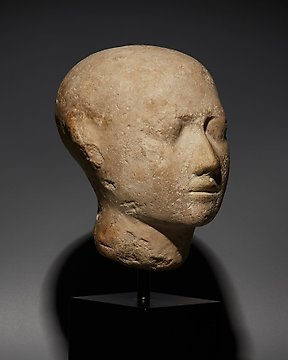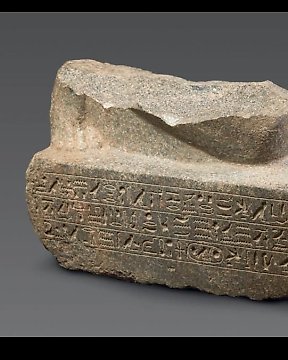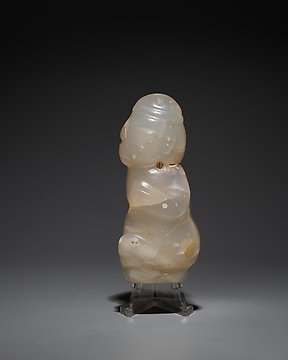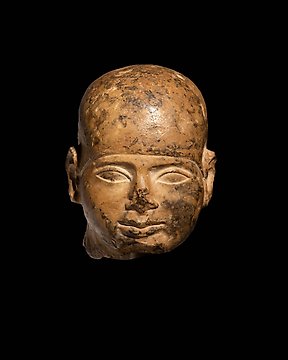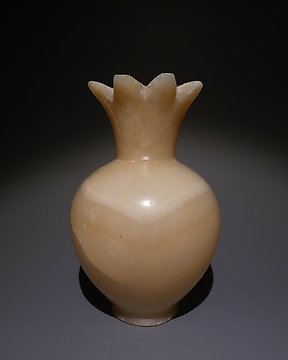Altägyptisch Holz Uschebti, Neues Reich, 18. - 19. Dynastie, 1552 - 1186 v. Chr. Höhe 21,9 cm.
Nr. 84871125

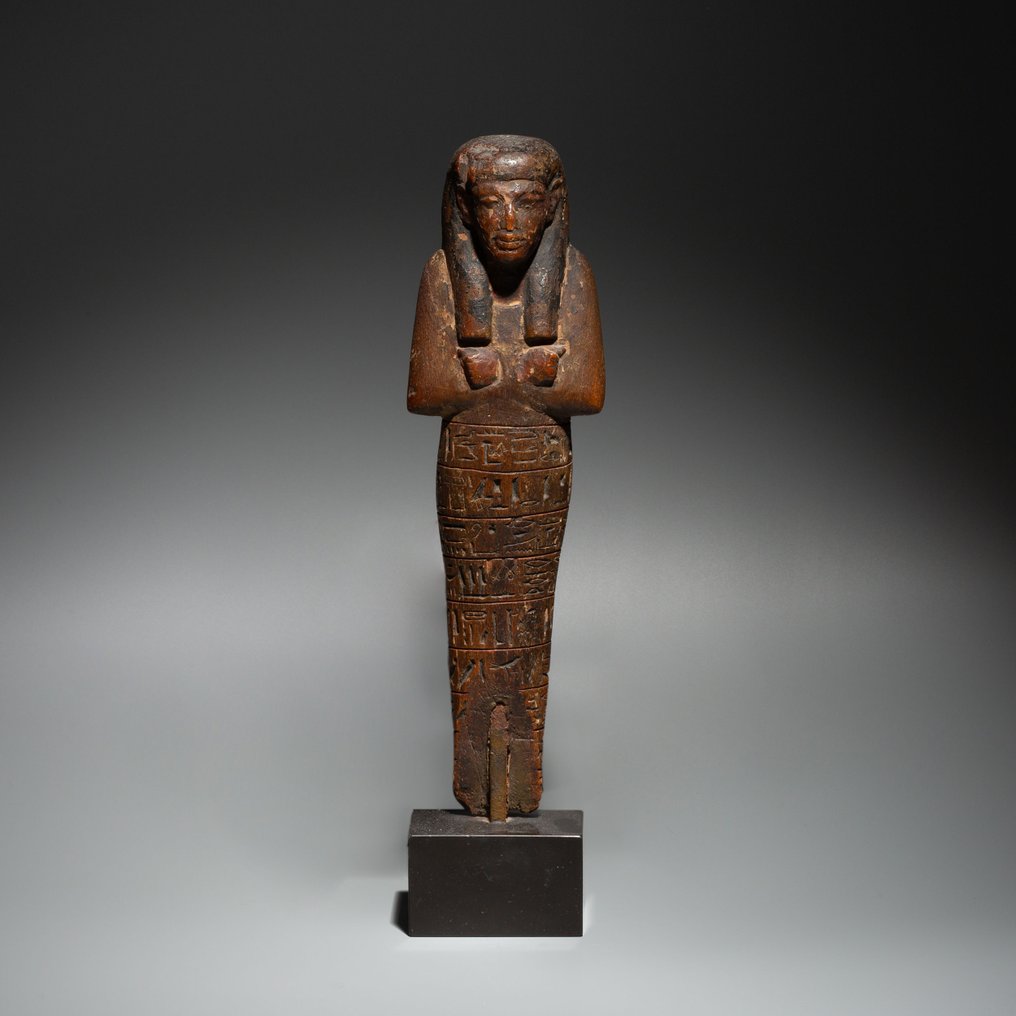

Ushebti.
- Good Quality! -
- Important Piece! -
Ancient Egypt, New Kingdom, 18th - 19th Dynasty, 1552 - 1186 BC.
MATERIAL: Wood and pigments.
DIMENSIONS: Height 21.9 centimeters.
PROVENANCE: - Private collection, Switzerland. Acquired around 1970.
CONDITION: Good condition, maintains the original polychrome, especially in the upper part. He has lost the lower part of his insteps and feet.
BIBLIOGRAPHY:
- BOVOT, J. Les serviteurs funeraires royaux et princiers de l'Ancienne Egypte. Paris: Editions de la Reunion des musees nationeuax, 2003.
- GLEEN, J. Shabtis, a private view. Paris: Librairie Cybele, 2002.
- SCHNEIDER, H. D. Shabtis. Leiden: Rijksmuseum van Oudheden, 1997.
- STEWART, H. M. Egypyian shabtis. United Kingdom: Shire Egyptology, 1995.
DESCRIPTION:
Ushabti figure carved in wood and later polychrome. He is wearing a tripartite wig that descends between his shoulders. From his mummiform shroud that covers his entire body, only his hands clenched into fists stand out, crossed over his chest. Due to the multitude of parallels, each hand would hold two hoes, agricultural tools, or a scepter and flagellum, which would be represented through the use of polychrome. On the body it has eight registers of horizontal hieroglyphic writing incised in bas-relief.
The Egyptian Afterlife was understood as a mirror of the real world, where good and evil also had their place. The unjust and evil were punished for all eternity, while the righteous enjoyed a comfortable existence traveling with the solar god. Even so, the blessed deceased were also obligated to fulfill human needs and responsibilities, just as they were in life; Having what to eat and drink in the Hereafter was a constant concern. In the Kingdom of the Dead, where, as members of a hierarchical society governed by the gods, all the deceased—men and women, lords and servants, kings and queens—were obliged to work in the Fields of Iaru. They had to be willing to cultivate, sow, and reap the harvest.
In earthly life these basic production tasks were performed by those belonging to the lowest levels of society. To avoid this fate, the Egyptians sought a magical solution: they had one or more figures of themselves made to present when the emissaries of the reigning god Osiris called upon them to fulfill their obligations. Thus, these statuettes, incorporated into the funerary trousseau of the tomb, were images that represented both the master and the servant.
They are known by the name ushebtis , the initial word being sabty or shabty , a derivative of Sawab , whose meaning corresponds to the Greek word " persea ", a sacred tree with which the ancient Egyptians began to make these funerary effigies. It is towards the Third Intermediate Period, in the 21st dynasty, around 1,080 BC when the word wsbty , that is: " ushebty " , begins to be used . It is from then on that " ushebti " derives from the verb wsb , "to respond", whose meaning is "the one who responds."
Ushebtis were incorporated into the graves of ancient Egypt beginning in the First Intermediate Period. Its use increased during the Middle Kingdom, when the Egyptians began to write in the Sarcophagus Texts a formula, 472, for the ushabtis to respond to the call: «The Justified N., says, Oh you shabty , who You have been made for N, if N is called to his tasks, or if an unpleasant job is imposed on N as on any man in his work, you will say here I am. If N is called to watch over those who work there, returning over the new fields to plow the land, or to transport sand from east to west by boat, you will say here I am. The Justified N. This formula is written on the ushabtis , thus, in most cases, they appear engraved. Starting with the New Kingdom, a large number of innovations were introduced and examples with texts began to proliferate, somewhat broader texts, contemplated in chapter VI of the Book of the Dead. Even so, in many cases the text indicates only the name of the deceased, or a basic formula, with the name of a relative or the most important positions he held.
The ushabtis were made of wax, especially in the beginning, later in wood, and towards the end of the Middle Kingdom stone appeared, and from the New Kingdom the material par excellence would be faience. It is known that they were produced in series thanks to the conservation of molds since in some cases the engraved texts were unfinished, since the name of the owner was missing. Its most popular form was the mummy, until the introduction, towards the end of the 18th dynasty, of figures decorated with everyday dresses. Many carried tools for working the land, such as a basket, a pickaxe, or a hoe, as a reference to the task they were expected to perform in the Hereafter on behalf of their masters. The iconography, texts, materials, colors and their location in the tomb may suggest other symbolic meanings.
Sometimes they were placed inside wooden boxes, which could be ostentatious in terms of decoration or very simple. In the New Kingdom they came to be placed in miniature sarcophagi.
While at the beginning they were considered replicas of the extinct, in the New Kingdom and later, they came to be seen as servants or a kind of slave of the inanimate, which is why large quantities were produced. At first an ushabti was made for the deceased, however, as the different dynasties passed, large quantities of these statuettes were made for the deceased, made up of men and women, including specialists in different activities, who were sometimes directed by foremen who managed to differentiate themselves by wearing a skirt. Such is the case of Pharaoh Tutankhamun who had three hundred and sixty-five ushabtis at his disposal , one for each day of the year; thirty-six foremen, one for each group of ten workers, and twelve month leaders, one for each month of the year. This made a total of four hundred and thirteen servants in the Hereafter. Such was the fear of carrying out these actions demanded by Osiris that some burials included ushebtis who acted as "substitutes" for the main ones.
It is logical to think that no pharaoh wanted to carry out this type of task with his hands, so at the required moment he read the legend written on the body of the ushabti and it came to life to respond to the call, replacing him in the work.
Notes:
- The piece includes authenticity certificate.
- The piece includes Spanish Export License (Passport for European Union) - If the piece is destined outside the European Union a substitution of the export permit should be requested, can take between 1-2 weeks maximum.
- The seller guarantees that he acquired this piece according to all national and international laws related to the ownership of cultural property. Provenance statement seen by Catawiki.
Der Verkäufer stellt sich vor
Ushebti.
- Good Quality! -
- Important Piece! -
Ancient Egypt, New Kingdom, 18th - 19th Dynasty, 1552 - 1186 BC.
MATERIAL: Wood and pigments.
DIMENSIONS: Height 21.9 centimeters.
PROVENANCE: - Private collection, Switzerland. Acquired around 1970.
CONDITION: Good condition, maintains the original polychrome, especially in the upper part. He has lost the lower part of his insteps and feet.
BIBLIOGRAPHY:
- BOVOT, J. Les serviteurs funeraires royaux et princiers de l'Ancienne Egypte. Paris: Editions de la Reunion des musees nationeuax, 2003.
- GLEEN, J. Shabtis, a private view. Paris: Librairie Cybele, 2002.
- SCHNEIDER, H. D. Shabtis. Leiden: Rijksmuseum van Oudheden, 1997.
- STEWART, H. M. Egypyian shabtis. United Kingdom: Shire Egyptology, 1995.
DESCRIPTION:
Ushabti figure carved in wood and later polychrome. He is wearing a tripartite wig that descends between his shoulders. From his mummiform shroud that covers his entire body, only his hands clenched into fists stand out, crossed over his chest. Due to the multitude of parallels, each hand would hold two hoes, agricultural tools, or a scepter and flagellum, which would be represented through the use of polychrome. On the body it has eight registers of horizontal hieroglyphic writing incised in bas-relief.
The Egyptian Afterlife was understood as a mirror of the real world, where good and evil also had their place. The unjust and evil were punished for all eternity, while the righteous enjoyed a comfortable existence traveling with the solar god. Even so, the blessed deceased were also obligated to fulfill human needs and responsibilities, just as they were in life; Having what to eat and drink in the Hereafter was a constant concern. In the Kingdom of the Dead, where, as members of a hierarchical society governed by the gods, all the deceased—men and women, lords and servants, kings and queens—were obliged to work in the Fields of Iaru. They had to be willing to cultivate, sow, and reap the harvest.
In earthly life these basic production tasks were performed by those belonging to the lowest levels of society. To avoid this fate, the Egyptians sought a magical solution: they had one or more figures of themselves made to present when the emissaries of the reigning god Osiris called upon them to fulfill their obligations. Thus, these statuettes, incorporated into the funerary trousseau of the tomb, were images that represented both the master and the servant.
They are known by the name ushebtis , the initial word being sabty or shabty , a derivative of Sawab , whose meaning corresponds to the Greek word " persea ", a sacred tree with which the ancient Egyptians began to make these funerary effigies. It is towards the Third Intermediate Period, in the 21st dynasty, around 1,080 BC when the word wsbty , that is: " ushebty " , begins to be used . It is from then on that " ushebti " derives from the verb wsb , "to respond", whose meaning is "the one who responds."
Ushebtis were incorporated into the graves of ancient Egypt beginning in the First Intermediate Period. Its use increased during the Middle Kingdom, when the Egyptians began to write in the Sarcophagus Texts a formula, 472, for the ushabtis to respond to the call: «The Justified N., says, Oh you shabty , who You have been made for N, if N is called to his tasks, or if an unpleasant job is imposed on N as on any man in his work, you will say here I am. If N is called to watch over those who work there, returning over the new fields to plow the land, or to transport sand from east to west by boat, you will say here I am. The Justified N. This formula is written on the ushabtis , thus, in most cases, they appear engraved. Starting with the New Kingdom, a large number of innovations were introduced and examples with texts began to proliferate, somewhat broader texts, contemplated in chapter VI of the Book of the Dead. Even so, in many cases the text indicates only the name of the deceased, or a basic formula, with the name of a relative or the most important positions he held.
The ushabtis were made of wax, especially in the beginning, later in wood, and towards the end of the Middle Kingdom stone appeared, and from the New Kingdom the material par excellence would be faience. It is known that they were produced in series thanks to the conservation of molds since in some cases the engraved texts were unfinished, since the name of the owner was missing. Its most popular form was the mummy, until the introduction, towards the end of the 18th dynasty, of figures decorated with everyday dresses. Many carried tools for working the land, such as a basket, a pickaxe, or a hoe, as a reference to the task they were expected to perform in the Hereafter on behalf of their masters. The iconography, texts, materials, colors and their location in the tomb may suggest other symbolic meanings.
Sometimes they were placed inside wooden boxes, which could be ostentatious in terms of decoration or very simple. In the New Kingdom they came to be placed in miniature sarcophagi.
While at the beginning they were considered replicas of the extinct, in the New Kingdom and later, they came to be seen as servants or a kind of slave of the inanimate, which is why large quantities were produced. At first an ushabti was made for the deceased, however, as the different dynasties passed, large quantities of these statuettes were made for the deceased, made up of men and women, including specialists in different activities, who were sometimes directed by foremen who managed to differentiate themselves by wearing a skirt. Such is the case of Pharaoh Tutankhamun who had three hundred and sixty-five ushabtis at his disposal , one for each day of the year; thirty-six foremen, one for each group of ten workers, and twelve month leaders, one for each month of the year. This made a total of four hundred and thirteen servants in the Hereafter. Such was the fear of carrying out these actions demanded by Osiris that some burials included ushebtis who acted as "substitutes" for the main ones.
It is logical to think that no pharaoh wanted to carry out this type of task with his hands, so at the required moment he read the legend written on the body of the ushabti and it came to life to respond to the call, replacing him in the work.
Notes:
- The piece includes authenticity certificate.
- The piece includes Spanish Export License (Passport for European Union) - If the piece is destined outside the European Union a substitution of the export permit should be requested, can take between 1-2 weeks maximum.
- The seller guarantees that he acquired this piece according to all national and international laws related to the ownership of cultural property. Provenance statement seen by Catawiki.
Der Verkäufer stellt sich vor
- 755
- 7
- 0
goede foto's, goede omschrijving, goed verpakt en snel verzonden.
Übersetzung ansehenmolto bello tutto ok
Übersetzung ansehenPezzo come da descrizione, davvero notevole. Venditore molto consigliato in quanto gentile e disponibile. spedizione molto veloce. Ottimo!
Übersetzung ansehenVenditore davvero ottimo e gentile. Merce come da descrizione, spedizione veloce. Ottimo l'avere certificato di autenticità.
Übersetzung ansehenUn 100 como empresa un 100 como envío . Empresa muy especial con mucha exquisitez en todos los productos y en personal . Muchas gracias
Übersetzung ansehenAll well! Thanks.
Übersetzung ansehenVery nice and fine cut little jewel! Well packed too! Thanks!
Übersetzung ansehennice piece and very fast shipping!
Übersetzung ansehenEs una maravilla de moneda, donde se le nota los pasos de los años y me encanta. Servido muy rápido y bien empaquetado. Con su certificación. Qué más se puede pedir?
Übersetzung ansehenSnelle en correcte levering, alleen was de verpakking voor het schilderij niet stevig genoeg.
Übersetzung ansehenHerzlichen Dank!
Übersetzung ansehenAll OK and with very fast shipping.
Übersetzung ansehenPrachtig schilderij. Zo blij mee. Zeer nette verkoper en zeer snelle levering.
Übersetzung ansehenperfect ! very fast and high quality delivery !
Übersetzung ansehenAll well! Thanks.
Übersetzung ansehenVendeur très professionnel, top +++×
Übersetzung ansehenPhotos trop contrastées pour bien percevoir les défauts, mais ces défauts étaient visibles pour autant. Le "Bon état" est trompeur. Sinon, envoi rapide et correctement emballé. Frais de port exagérés.
Übersetzung ansehenGreat communication, delivery and product. Came with a well made certificate of authenticity and good packaging. Overall very happy with the purchase! Delivery is a bit expensive, but I recommend it
Übersetzung ansehenMagnifique témoin du passé, envoyé avec tous les justificatifs, impeccable. Encore une fois très satisfait, un grand merci
Übersetzung ansehenThank you for the Special offer and the fast shipping of this excellent piece of art!
Übersetzung ansehenvery good description of the object, very good price for this rare item,. Fast sending (has been at my place 2 days after buying!). Definitely would buy again.
Übersetzung ansehenSehr schön
Übersetzung ansehenAs described, perfect logistic
Übersetzung ansehengreat seller, everything came as should with certificate of authenticity
Übersetzung ansehen- 755
- 7
- 0
Disclaimer
Der Verkäufer garantiert und kann belegen, dass das Objekt legal erworben wurde. Der Verkäufer wurde von Catawiki darüber informiert, dass er die Unterlagen, die gemäß den Gesetzen und Vorschriften seines Landes erforderlich sind, zur Verfügung stellen muss. Der Verkäufer garantiert, dass er berechtigt ist, das Objekt zu verkaufen/auszuführen. Der Verkäufer wird dem Käufer alle Informationen, die zur Provenienz des Objekts vorliegen, zur Verfügung stellen. Der Verkäufer versichert, dass alle erforderlichen Genehmigungen eingeholt wurden/werden. Der Verkäufer wird den Käufer unverzüglich über etwaige Verzögerungen bei der Einholung dieser Genehmigungen informieren.
Der Verkäufer garantiert und kann belegen, dass das Objekt legal erworben wurde. Der Verkäufer wurde von Catawiki darüber informiert, dass er die Unterlagen, die gemäß den Gesetzen und Vorschriften seines Landes erforderlich sind, zur Verfügung stellen muss. Der Verkäufer garantiert, dass er berechtigt ist, das Objekt zu verkaufen/auszuführen. Der Verkäufer wird dem Käufer alle Informationen, die zur Provenienz des Objekts vorliegen, zur Verfügung stellen. Der Verkäufer versichert, dass alle erforderlichen Genehmigungen eingeholt wurden/werden. Der Verkäufer wird den Käufer unverzüglich über etwaige Verzögerungen bei der Einholung dieser Genehmigungen informieren.

